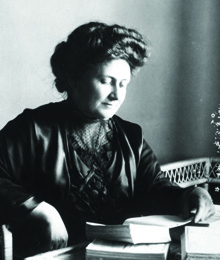Maria Montessori: An education system that passes the test of time
August 1, 2012 by Madeline Stephenson
Filed under General Interest

The Montessori method has methodically swept across the educational landscape, fostering young minds to think independently and shepherding parents to give their fawns a fair shot at a ripened yet revolutionary form of learning. With thousands of private and public schools across North America carrying on this legacy, why are Maria Montessori’s early 20th century revelations still so relevant?
The answer to this question is something John Chattin-McNichols, an associate professor of education at Seattle University, stumbled upon after he embarked on a serendipitous trip to Bergamo, Italy in 1970 — exactly 100 years after Montessori was born in a small town just a few hours away. At the time, the-then 20 year old was working as a summer helper at a Montessori school in the U.S., teaching preschoolers archery, ice-skating and other activities when he was approached to attend a training course abroad. “Because none of the more competent teachers could go, because they all had families and I was a student, I got a paid trip to go take the elementary Montessori training in northern Italy,” says Chattin-McNichols, who was given a $2,000 stipend to live on for 10 months. “I weighed 70 pounds less than I do now when I got back,” he says with a laugh. Slender, solo and strapped for cash, it’s fair to say he had a lot to lose, but what he gained during his time at the University of Bergamo is something that would ultimately change the course of his life.
Beneath the umbrella of a southern European sun, Chattin-McNichols absorbed the rays of a radical framework of education that intrigued him. “The goal of Montessori isn’t to have everyone march in step — the goal of Montessori is to maximize individual learning … real individualization, not just railroad-track individualization,” he says of the eminent method that heavily relies on observation to determine the distinct needs of each child. Divided into three-year multi-age groups, the Montessori method is supported by a prepared, child-centric realm that sets the stage for autonomous growth in a non-competitive atmosphere. “We discovered that education is not something which the teacher does, but that it is a natural process which develops spontaneously in the human being. It is not acquired by listening to words, but in virtue of experiences in which the child acts on his environment,” Montessori wrote in The Absorbent Mind. Chattin-McNichols quickly realized how revered the late Nobel Peace Prize nominee was in her native country. “They really loved having a world-famous person having been an Italian, and women, I think, resonated with the fact that she had been a feminist,” he says. So who exactly was she?
Born in Chiaravalle, Italy, in 1870, Montessori was, from the outset, a radical young woman. Deemed progressive for her era, she rebelled against her father’s wishes and fought to be accepted into a male-dominated medical program at the University of Rome. Her against-the-grain goal to become one of Italy’s first female physicians may not have fit into the narrow confines of social conformism at the time, but Montessori prescribed to a modern paradigm and embarked on a pilgrimage to discover new paths. “First of all, she’s enormously bright; secondly, she’s enormously stubborn,” says Chattin-McNichols of the woman who not only redefined the conventional role of women, but set out to shake up the edifice of education.
The foundation was laid with the inception of a day care centre she founded in 1907. It was a move that spun off from observing and working with sensory-deprived children at an orphanage after becoming a physician. At the time, Italy was in an economically transformative phase, where slums were being torn down and tenements were popping up. “A man who built a particular tenement found that the kids were running wild and he wanted to start a school. Because he knew of [Montessori’s] work, he asked her if she would start a child care centre,” says Phyllis Povell, author of Montessori Comes to America: The Leadership of Maria Montessori and Nancy McCormick Rambusch. It was a challenge Montessori accepted, and it led to the subsequent birth of Casa dei Bambini in Rome, Montessori’s very first school. It was there that her famed method began to crawl, walk and eventually run through the streets of Italy.
“Montessori created a school environment to make up for the impoverished conditions of many of the children’s homes. She determined that, to be comfortable, young children need furnishings their own size and tools that fit their small hands,” writes Carol Garhart Mooney in Theories of Childhood: An Introduction to Dewey, Montessori, Erikson, Piaget, and Vygotsky. Her response to the lack of available resources was simply to develop them herself. And so she did, along with a set of standards and principles that seemed to favour the advancement of children’s minds over the inclinations of their parents. Eliminating society’s emphasis to strive for perfection was a matter of great importance to Montessori, who shunned the customary corrective marks made by teachers on students’ assignments and tests. “To tell a child he is naughty or stupid just humiliates him; it offends and insults, but does not improve him. For if a child is to stop making mistakes, he must become more skillful, and how can he do this if, being already below standard, he is also discouraged?” wrote Montessori in The Absorbent Mind, a book named after her theory that the child’s mind is most permeable from birth to age six.
While a trip to Vaughan’s Pierre Berton Resource Library proves there is a litany of literature on Montessori and her popular method, there is still a lot the world doesn’t know about this elusive leader. For example, almost every book and online report states that she was Italy’s first female doctor, but Povell brings brazen clarity to the claims. Sifting through her exhaustive files from her New York home — complete with a framed towel featuring Montessori’s face on the 1,000-lira note — she begins reciting a chronological list of Italy’s female physicians, including their graduating years, and stops at No. 8: Maria Montessori. “I wrote to every medical school in Italy,” she says of the information she acquired while working on her doctorate. “Once I started to read her materials and her life, I became very excited.”
Montessori schools have not survived the past century without some criticism. Unlike the rudimentary days where Montessori focused her efforts on less fortunate kids, her method has since become synonymous with a certain pillar of exclusivity. A few phone calls to local Montessori schools proves that tuition fees can range from $7,000 to as much as $22,000 annually for full-time students, with the average rate around $10,000. So the palpable hindrance for some parents continues to be cost. Povell believes that this likely stems from the fact that late educator and inaugural president of the American Montessori Society (AMS), Nancy Rambusch, revived the approach in the wealthy town of Greenwich, Connecticut in 1957, spurring a movement for others to open more schools in similarly affluent neighbourhoods. “Nancy worked very hard so that it wouldn’t be just another alternative, but it would be a social movement, it would be an educational movement; it would be part of the fabric of society, where it runs from public schools, chartered schools and middle class and upper class, that everybody can have it,” says Povell, adding that the curriculum is becoming much more obtainable for all income levels in the U.S.
Another cord of contention is the fact that the Montessori name is not protected by trademark, making it that much more crucial for parents to do some investigating before investing money into a curriculum that may or may not actually incorporate Montessori methods and materials. This is one of the reasons Erin Higginbottom, vice-chair of the Montessori Society of Canada, says it’s difficult to pin down the precise number of legitimate Montessori schools that exist in Canada (though she estimates it to be around 500). “There are definitely a few key components of the program that you’re looking for. The first is that they are accredited or affiliated with one of the larger associations like AMS, AMI [Association Montessori Internationale] or TMI [Toronto Montessori Institute],” says Higginbottom, adding that it is also important to ensure that the environment is properly prepared. For those who are still on the fence, Chattin-McNichols — who went on to fulfill the role of president of the AMS for a period — recommends visiting local coffee shops closest to the schools being considered at around 9:30 a.m., when parents have just dropped off their kids. “That’s when you find out how they’re doing, which teachers are good and things like that,” he says.
Though more than 100 years have passed since Maria Montessori set off a scholastic revolution in the streets of Rome, her method continues to remain significant at educational addresses around the world. “I think it’s really relevant because it’s individualized. Each child grows in his or her own time, in his or her own methods, in his or her own content,” says Povell. “She was a woman ahead of her time.”
www.montessorisocietycanada.org
www.tmi.edu
www.montessori-ami.org
www.amshq.org









Comments
Feel free to leave a comment...
and oh, if you want a pic to show with your comment, go get a gravatar!